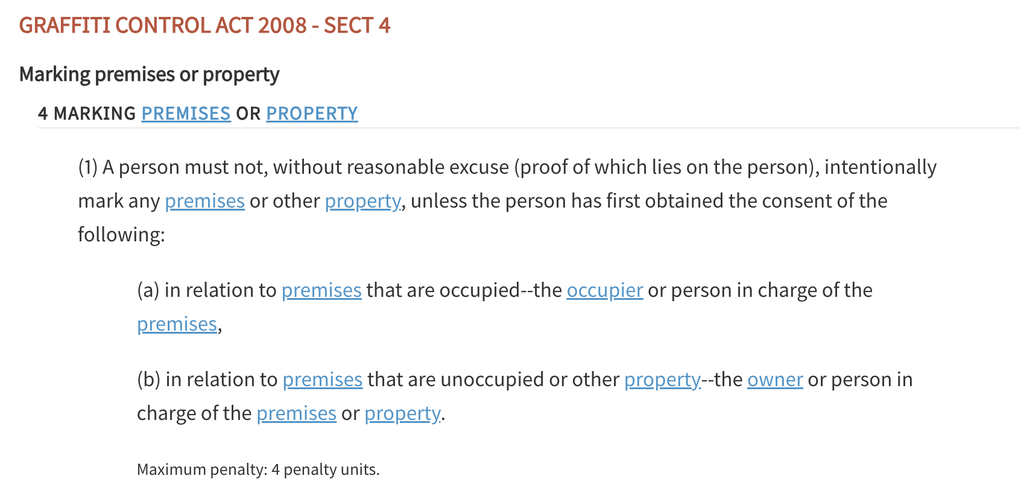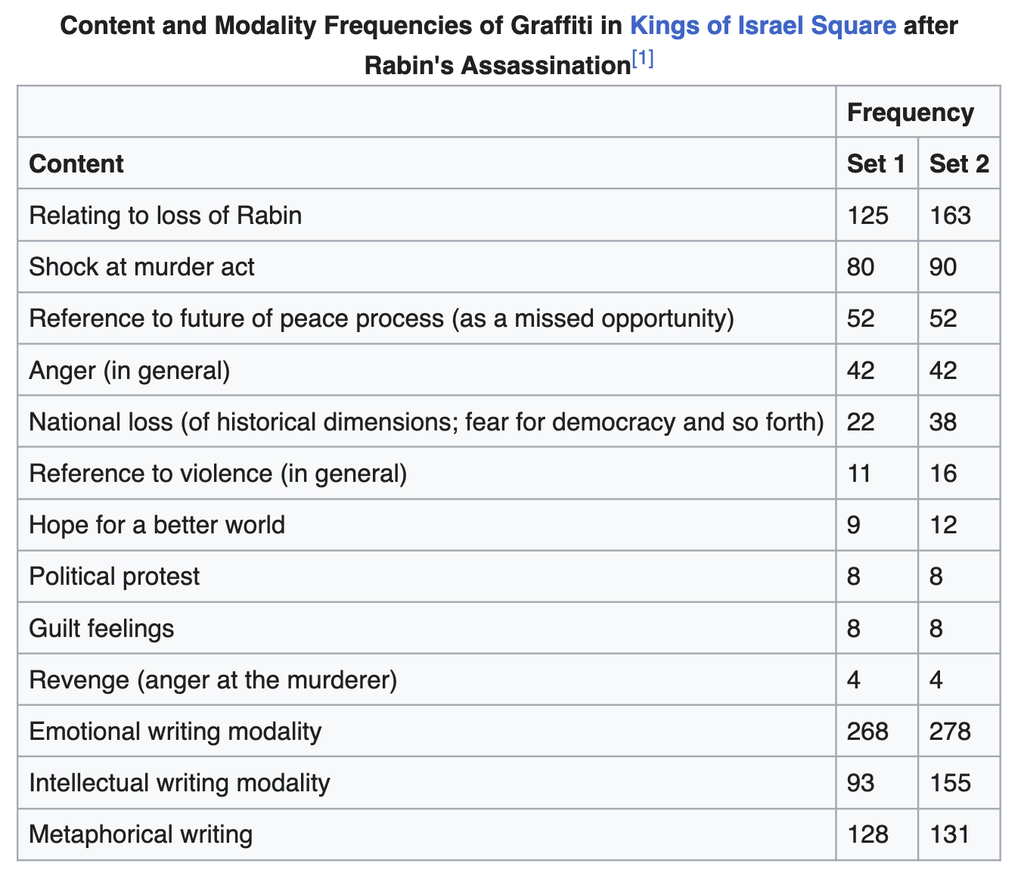
(כד) בֵּאדַ֙יִן֙ מִן־קֳדָמ֔וֹהִי שְׁלִ֖יחַ פַּסָּ֣א דִֽי־יְדָ֑א וּכְתָבָ֥א דְנָ֖ה רְשִֽׁים׃ (כה) וּדְנָ֥ה כְתָבָ֖א דִּ֣י רְשִׁ֑ים מְנֵ֥א מְנֵ֖א תְּקֵ֥ל וּפַרְסִֽין׃ (כו) דְּנָ֖ה פְּשַֽׁר־מִלְּתָ֑א מְנֵ֕א מְנָֽה־אֱלָהָ֥א מַלְכוּתָ֖ךְ וְהַשְׁלְמַֽהּ׃
(24) He therefore made the hand appear, and caused the writing to be inscribed. (25) This is the writing that is inscribed: MENE MENE TEKEL UPHARSIN. (26) And this is its meaning: MENE—God has numberedbAramaic mena. [the days of] your kingdom and brought it to an end;
Karen Stern, "Writing on the Wall: Graffiti and the Forgotten Jews of Antiquity"
Imagine that you entered a synagogue and saw somebody writing her name on the wall. Or that you visited a cemetery and spied someone with a penknife carving a message into the nearest headstone. How would you—or any reasonable bystander—react? Perhaps you would notify the local authorities. After all, acts of writing graffiti are illegal inside places of worship and burial, as they are associated with vandalism, defacement, and disrespect.
But these same types of behavior resonated differently in antiquity.
Throughout the ancient world, many people, including Jews, carved and painted words and pictures (we might call them graffiti today) in places that would shock modern sensibilities—inside and around holy spaces and shrines, pagan sanctuaries, synagogues, and churches; and throughout cemeteries, necropoleis, and tombs in regions of modern Israel, Syria, Greece, Italy, Malta, Sardinia, Tunisia, and Libya. The ancients also made their marks in other locations: upon cliffs and open-air sanctuaries along desert roads and trade routes of Egypt, the Sinai Peninsula, and Saudi Arabia; and around public theaters and hippodromes (horse racecourses) along the Syrian coast (modern Lebanon) and Asia Minor (the Asian portion of modern Turkey).
...For instance, upon doorways from a third-century C.E. synagogue in Dura-Europos in Roman Syria, a man called Hiya carved “I am Hiya!” multiple times. Other writers, such as a certain Ahiah, wrote prayers and requests for divine remembrance on synagogue surfaces (“remembered be Ahiah … before the Lord in Heaven!”), while still other visitors to the synagogue scratched pictures of horses into the elaborately painted walls of the assembly hall.
...
One person, for example, scrawled a sign around an entrance to the complex to offer well wishes to the dead, proclaiming, “Good luck on your resurrection!” Others painted curses in Greek and Aramaic above and inside of tombs to deter grave-robbers. Their writings condemned to suffer those who would disturb the surrounding graves. (“He who resurrects the dead shall judge him [who violates a tomb]!”)
...
Their writings and drawings, in so doing, attest to associated activities that they once performed—in their own terms, in their own voice. Thus, what makes graffiti seemingly mundane is actually what makes them most significant: They index the daily activities of nonelite Jews, whose lives and behaviors otherwise elude historical report.



לֹא יַעֲשֶׂה אָדָם...מְנוֹרָה כְּנֶגֶד מְנוֹרָה. אֲבָל עוֹשֶׂה שֶׁל חֲמִשָּׁה וְשֶׁל שִׁשָּׁה וְשֶׁל שְׁמוֹנָה. וְשֶׁל שִׁבְעָה — לֹא יַעֲשֶׂה, אֲפִילּוּ שֶׁל שְׁאָר מִינֵי מַתָּכוֹת. רַבִּי יוֹסֵי בַּר יְהוּדָה אוֹמֵר: אַף שֶׁל עֵץ לֹא יַעֲשֶׂה, כְּדֶרֶךְ שֶׁעָשׂוּ מַלְכֵי בֵּית חַשְׁמוֹנַאי.
As it is taught: One shouldn't make a duplicate of the Menorah, like the original Menorah. One can make a menorah with five branches or six or eight. But one shouldn't make one of seven, even if it is of another metal besides gold. R. Yose bar Yehudah says: One shouldn't make it of wood, like the kings of the Hasmoneans did.
בָּעֵי רָבָא: נֵר חֲנוּכָּה וְקִידּוּשׁ הַיּוֹם מַהוּ? קִידּוּשׁ הַיּוֹם עֲדִיף — דִּתְדִיר, אוֹ דִילְמָא נֵר חֲנוּכָּה עֲדִיף — מִשּׁוּם פַּרְסוֹמֵי נִיסָּא? בָּתַר דְּבַעְיַהּ, הֲדַר פַּשְׁטַהּ: נֵר חֲנוּכָּה עֲדִיף, מִשּׁוּם פַּרְסוֹמֵי נִיסָּא.
However, Rava raised a dilemma: When the conflict is between oil for a Hanukkah lamp or wine for kiddush of Shabbat day, what is the ruling in that case? Does kiddush of Shabbat day take priority because it is frequent, i.e., it is performed every week, and there is a principle: When there is a conflict between a frequent practice and an infrequent practice, the frequent practice takes precedence? Or, perhaps the Hanukkah lamp takes precedence due to publicity of the miracle? After he raised the dilemma, he then resolved it on his own and he ruled that, in that case, the Hanukkah lamp takes precedence due to publicity of the miracle.
QUESTION: The Chanukah Menorah is kindled on the outside of one’s home because of Pirsumei Nisa — the requirement to publicize the miracle. This same concept is also found in regard to drinking four cups of wine on Pesach (Maggid Mishnah, Chanukah 4:12), and also a reason for folding the Megillah to resemble a written letter when it is read on Purim (Rambam, Megillah 2:12).
Why in those instances is the miracle publicised on the inside — among our Jewish brethren — while on Chanukah it is publicized to the non-Jewish world?
ANSWER: Whenever a Jew is thankful about his physical survival, he does not have to communicate it to non-Jews, since physical self-survival is a common instinct among all humans and animals, and it is understood that Jews will fight for their physical survival. This type of miracle does not require publicizing among non-Jews.
Thus, Purim and Pesach, which commemorate our rescue from physical annihilation and slavery, need not be shared with non-Jews since they are well cognisant that Jews like any other human beings will fight ferociously for their physical survival.
On Chanukah, however, the Jews’ spiritual survival and not their physical survival was at stake. The message which we wish to convey to non-Jews is that Jews are willing and able to fight for their spiritual survival as well as their physical well-being, and that the Jews returned from the brink of total assimilation...
The message of Chanukah is more of a sensation to non-Jews than is the message of Purim and Pesach, and thus, the pirsumei nissa conveyed by the Chanukah lights is directed at non-Jews as well.
(Rav Soloveitchik)
The Syrian-Greeks endeavored to detach the Jews from Torah study. However, they did not suffice with this evil plan, but also demanded that the Jews write on the horn of the ox that they were denouncing their share in the G‑d of Israel (Midrash Rabbah, Bereishit 2:4).
So, my fellow Jews - vandalise* the world with our Jewishness. Write it on your 'walls', wear it around your necks, weave it into your words.



